Hybrid Approaches for Selective Laser Sintering by Building on Dissimilar Materials
Abstract
:1. Introduction
2. Materials and Methods
3. Results and Discussion
4. Conclusions
Author Contributions
Funding
Conflicts of Interest
References
- Grujicic, M.; Sellappan, V.; Omar, M.A.; Seyr, N.; Obieglo, A.; Erdmann, M.; Holzleitner, J. An overview of the polymer-to-metal direct-adhesion hybrid technologies for load-bearing automotive components. J. Mater. Process. Technol. 2008, 197, 363–373. [Google Scholar] [CrossRef]
- Carradò, A.; Faerber, J.; Niemeyer, S.; Ziegmann, G.; Palkowski, H. Metal/polymer/metal hybrid systems: Towards potential formability applications. Compos. Struct. 2011, 93, 715–721. [Google Scholar] [CrossRef]
- Grujicic, M.; Sellappan, V.; Kotrika, S.; Arakere, G.; Obieglo, A.; Erdmann, M.; Holzleitner, J. Suitability analysis of a polymer–metal hybrid technology based on high-strength steels and direct polymer-to-metal adhesion for use in load-bearing automotive body-in-white applications. J. Mater. Process. Technol. 2009, 209, 1877–1890. [Google Scholar] [CrossRef]
- Michaeli, W.; Pfefferkorn, T.G. Electrically conductive thermoplastic/metal hybrid materials for direct manufacturing of electronic components. Polym. Eng. Sci. 2009, 49, 1511–1524. [Google Scholar] [CrossRef]
- Beg, S.; Rahman, M.; Jain, A.; Saini, S.; Midoux, P.; Pichon, C.; Ahmad, F.J.; Akhter, S. Nanoporous metal organic frameworks as hybrid polymer-metal composites for drug delivery and biomedical applications. Drug Discov. Today 2017, 22, 625–637. [Google Scholar] [CrossRef]
- Lee, J.-W.; Hart, D.L.; Shinn, E.T.; Cooley, A.J.; White, E.L.; MacDowell, P.W.; Schomburg, E.; Slenski, G.A.; Watkins, A.N.; Yang, R.L. Multifunctional Metal/Polymer Hybrid Fiber for Space and Aerospace Applications. MRS Proc. 2004, 851. [Google Scholar] [CrossRef]
- Wagner, G.; Balle, F.; Eifler, D. Ultrasonic Welding of Aluminum Alloys to Fiber Reinforced Polymers. Adv. Eng. Mater. 2013, 15, 792–803. [Google Scholar] [CrossRef]
- Sankaranarayanan, R.; Hynes, N.R.J. Prospects of joining multi-material structures. In Proceedings of the 2nd International Conference on Condensed Matter and Applied Physics (ICC2017), Bikaner, India, 24–25 November 2017; p. 130021. [Google Scholar]
- Lamberti, C.; Solchenbach, T.; Plapper, P.; Possart, W. Laser Assisted Joining of Hybrid Polyamide-aluminum Structures. Phys. Procedia 2014, 56, 845–853. [Google Scholar] [CrossRef] [Green Version]
- Biron, M. Future Prospects for Thermoplastics and Thermoplastic Composites. In Thermoplastics and Thermoplastic Composites, 2nd ed.; Biron, M., Ed.; Elsevier/William Andrew: Amsterdam, The Netherlands, 2013; pp. 985–1025. ISBN 9781455778980. [Google Scholar]
- Kah, P.; Suoranta, R.; Martikainen, J.; Magnus, C. Techniques for joining dissimilar materials: Metals and polymers. Rev. Adv. Mater. Sci. 2014, 36, 152–164. [Google Scholar]
- Amancio-Filho, S.T.; dos Santos, J.F. Joining of polymers and polymer-metal hybrid structures: Recent developments and trends. Polym. Eng. Sci. 2009, 49, 1461–1476. [Google Scholar] [CrossRef]
- Silva, L.F.M.d.; Pirondi, A.; Öchsner, A. Hybrid Adhesive Joints; Springer: Berlin/Heidelberg, Germany, 2011; ISBN 9783642166228. [Google Scholar]
- Kweon, J.-H.; Jung, J.-W.; Kim, T.-H.; Choi, J.-H.; Kim, D.-H. Failure of carbon composite-to-aluminum joints with combined mechanical fastening and adhesive bonding. Compos. Struct. 2006, 75, 192–198. [Google Scholar] [CrossRef]
- Genest, M.; Martinez, M.; Mrad, N.; Renaud, G.; Fahr, A. Pulsed thermography for non-destructive evaluation and damage growth monitoring of bonded repairs. Compos. Struct. 2009, 88, 112–120. [Google Scholar] [CrossRef]
- Bergmann, J.P.; Stambke, M. Potential of Laser-manufactured Polymer-metal hybrid Joints. Phys. Procedia 2012, 39, 84–91. [Google Scholar] [CrossRef] [Green Version]
- Schricker, K.; Stambke, M.; Bergmann, J.P.; Bräutigam, K.; Henckell, P. Macroscopic Surface Structures for Polymer-metal Hybrid Joints Manufactured by Laser Based Thermal Joining. Phys. Procedia 2014, 56, 782–790. [Google Scholar] [CrossRef] [Green Version]
- Heckert, A.; Zaeh, M.F. Laser Surface Pre-treatment of Aluminium for Hybrid Joints with Glass Fibre Reinforced Thermoplastics. Phys. Procedia 2014, 56, 1171–1181. [Google Scholar] [CrossRef] [Green Version]
- Holtkamp, J.; Roesner, A.; Gillner, A. Advances in hybrid laser joining. Int. J. Adv. Manuf. Technol. 2010, 47, 923–930. [Google Scholar] [CrossRef]
- Merklein, M.; Junker, D.; Schaub, A.; Neubauer, F. Hybrid Additive Manufacturing Technologies—An Analysis Regarding Potentials and Applications. Phys. Procedia 2016, 83, 549–559. [Google Scholar] [CrossRef] [Green Version]
- Gao, W.; Zhang, Y.; Ramanujan, D.; Ramani, K.; Chen, Y.; Williams, C.B.; Wang, C.C.L.; Shin, Y.C.; Zhang, S.; Zavattieri, P.D. The status, challenges, and future of additive manufacturing in engineering. Comput. Aided Des. 2015, 69, 65–89. [Google Scholar] [CrossRef]
- Petrovic, V.; Vicente Haro Gonzalez, J.; Jordá Ferrando, O.; Delgado Gordillo, J.; Ramón Blasco Puchades, J.; Portolés Griñan, L. Additive layered manufacturing: Sectors of industrial application shown through case studies. Int. J. Prod. Res. 2011, 49, 1061–1079. [Google Scholar] [CrossRef]
- Gibson, I.; Rosen, D.W.; Stucker, B. Additive Manufacturing Technologies; Springer: Boston, MA, USA, 2010; ISBN 978-1-4419-1119-3. [Google Scholar]
- Hopkinson, N.; Dickens, P.M.; Hague, R.J.M. Rapid manufacturing. In An Industrial Revolution for the Digital Age; John Wiley: Chichester, UK, 2006; ISBN 0470016132. [Google Scholar]
- Vaezi, M.; Chianrabutra, S.; Mellor, B.; Yang, S. Multiple material additive manufacturing—Part 1: A review. Virtual Phys. Prototyp. 2013, 8, 19–50. [Google Scholar] [CrossRef]
- Bandyopadhyay, A.; Heer, B. Additive manufacturing of multi-material structures. Mater. Sci. Eng. R Rep. 2018, 129, 1–16. [Google Scholar] [CrossRef]
- Woitun, D.; Roderus, M.; Bein, T.; Kroner, E. Metal Polymer Connections: Laser-Induced Surface Enlargement Increases Joint Strength. Key Eng. Mater. 2019, 809, 190–196. [Google Scholar] [CrossRef]
- Silva, M.; Felismina, R.; Mateus, A.; Parreira, P.; Malça, C. Application of a Hybrid Additive Manufacturing Methodology to Produce a Metal/Polymer Customized Dental Implant. Procedia Manuf. 2017, 12, 150–155. [Google Scholar] [CrossRef]
- US20170057164A1—Hybrid Additive Manufacturing Method and Apparatus Made Therefrom—Google Patents. Available online: https://patents.google.com/patent/US20170057164A1/en (accessed on 2 May 2020).
- Trautmann, A.; Götzendorfer, B.; Walther, T.; Hellmann, R. Scaffolds in a shell-a new approach combining one-photon and two-photon polymerization. Opt. Express 2018, 26, 29659–29668. [Google Scholar] [CrossRef] [PubMed]
- Falck, R.; Goushegir, S.M.; dos Santos, J.F.; Amancio-Filho, S.T. AddJoining: A novel additive manufacturing approach for layered metal-polymer hybrid structures. Mater. Lett. 2018, 217, 211–214. [Google Scholar] [CrossRef]
- Hopmann, C.; Kreimeier, S.; Keseberg, J.; Wenzlau, C. Joining of Metal-Plastics-Hybrid Structures Using Laser Radiation by Considering the Surface Structure of the Metal. J. Polym. 2016, 1–10. [Google Scholar] [CrossRef] [Green Version]
- Roesner, A.; Scheik, S.; Olowinsky, A.; Gillner, A.; Reisgen, U.; Schleser, M. Laser Assisted Joining of Plastic Metal Hybrids. Phys. Procedia 2011, 12, 370–377. [Google Scholar] [CrossRef]
- Van der Straeten, K.; Burkhardt, I.; Olowinsky, A.; Gillner, A. Laser-induced Self-organizing Microstructures on Steel for Joining with Polymers. Phys. Procedia 2016, 83, 1137–1144. [Google Scholar] [CrossRef]
- Yadroitsev, I.; Smurov, I. Surface Morphology in Selective Laser Melting of Metal Powders. Phys. Procedia 2011, 12, 264–270. [Google Scholar] [CrossRef] [Green Version]
- Abele, E.; Stoffregen, H.A.; Kniepkamp, M.; Lang, S.; Hampe, M. Selective laser melting for manufacturing of thin-walled porous elements. J. Mater. Process. Technol. 2015, 215, 114–122. [Google Scholar] [CrossRef]
- DIN EN 1465:2009-07. Klebstoffe_-Bestimmung der Zugscherfestigkeit von Überlappungsklebungen; Deutsche Fassung EN_1465:2009; Beuth Verlag GmbH: Berlin, Germany, 2009.
- Nelson, C.J. Selective Laser Sintering: A Definition of the Process and an Empirical Sintering Model. Ph.D. Thesis, University of Texas at Austin, Austin, TA, USA, 1993. [Google Scholar]
- Starr, T.L.; Gornet, T.J.; Usher, J.S. The effect of process conditions on mechanical properties of laser-sintered nylon. Rapid Prototyp. J. 2011, 17, 418–423. [Google Scholar] [CrossRef]
- Wegner, A.; Witt, G. Understanding the decisive thermal processes in laser sintering of polyamide 12. In Proceedings of the PPS-30: The 30th International Conference of the Polymer Processing Society—Conference Papers, Cleveland, OH, USA, 6–12 June 2014; AIP Publishing LLC: Melville, NY, USA, 2015; p. 160004. [Google Scholar]
- Kumpatny, D.S.; Cottrill, A.; Hollett, A.; Barrett, J.; Kamara, S. An experimental Study of Heat Transfer in Selective Laser Sintering process. In Proceedings of the 9th International Conference on Engineering Education, San Juan, Purte Rico, 23–28 July 2006. M5K 5–11.
- Singh, A.K.; Srinivasa Prakash, R. Response surface-based simulation modeling for selective laser sintering process. Rapid Prototyp. J. 2010, 16, 441–449. [Google Scholar] [CrossRef]
- Hopkinson, N.; Majewski, C.E.; Zarringhalam, H. Quantifying the degree of particle melt in Selective Laser Sintering ®. Cirp Ann. 2009, 58, 197–200. [Google Scholar] [CrossRef]
- Vasquez, M.; Haworth, B.; Hopkinson, N. Optimum sintering region for laser sintered nylon-12. J. Eng. Manuf. 2011, 225, 2240–2248. [Google Scholar] [CrossRef] [Green Version]
- Bassoli, E.; Gatto, A.; Iuliano, L. Joining mechanisms and mechanical properties of PA composites obtained by selective laser sintering. Rapid Prototyp. J. 2012, 18, 100–108. [Google Scholar] [CrossRef] [Green Version]
- Osmanlic, F.; Wudy, K.; Laumer, T.; Schmidt, M.; Drummer, D.; Körner, C. Modeling of Laser Beam Absorption in a Polymer Powder Bed. Polymers 2018, 10, 784. [Google Scholar] [CrossRef] [Green Version]
- Laumer, T.; Wudy, K.; Drexler, M.; Amend, P.; Roth, S.; Drummer, D.; Schmidt, M. Fundamental investigation of laser beam melting of polymers for additive manufacture. J. Laser Appl. 2014, 26, 42003. [Google Scholar] [CrossRef]
- Ziegelmeier, S.; Christou, P.; Wöllecke, F.; Tuck, C.; Goodridge, R.; Hague, R.; Krampe, E.; Wintermantel, E. An experimental study into the effects of bulk and flow behaviour of laser sintering polymer powders on resulting part properties. J. Mater. Process. Technol. 2015, 215, 239–250. [Google Scholar] [CrossRef]
- Sancaktar, E.; Lu, H. The effects of excimer laser irradiation at 248 nm on the surface mass loss and thermal properties of PS, ABS, PA6, and PC polymers. J. Appl. Polym. Sci. 2006, 99, 1024–1037. [Google Scholar] [CrossRef]
- Amend, P.; Pfindel, S.; Schmidt, M. Thermal Joining of Thermoplastic Metal Hybrids by Means Of Mono- and Polychromatic Radiation. Phys. Procedia 2013, 41, 98–105. [Google Scholar] [CrossRef] [Green Version]

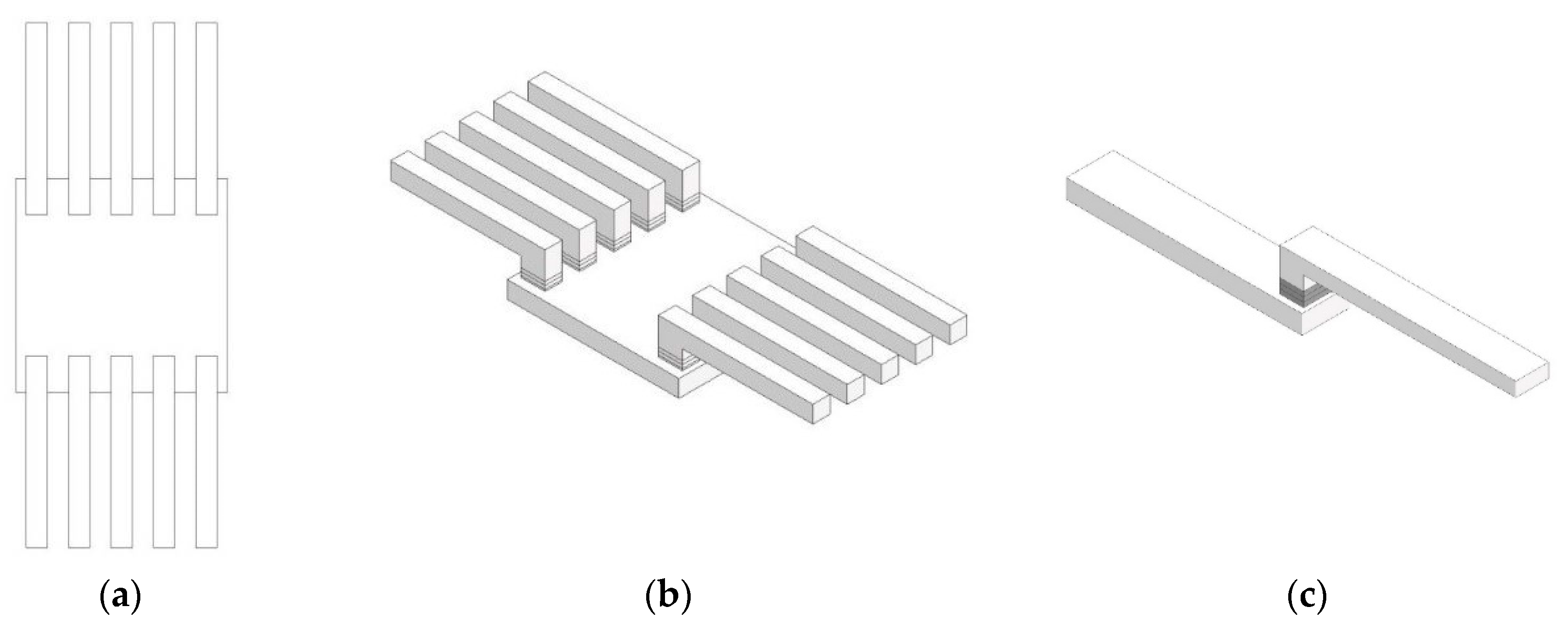

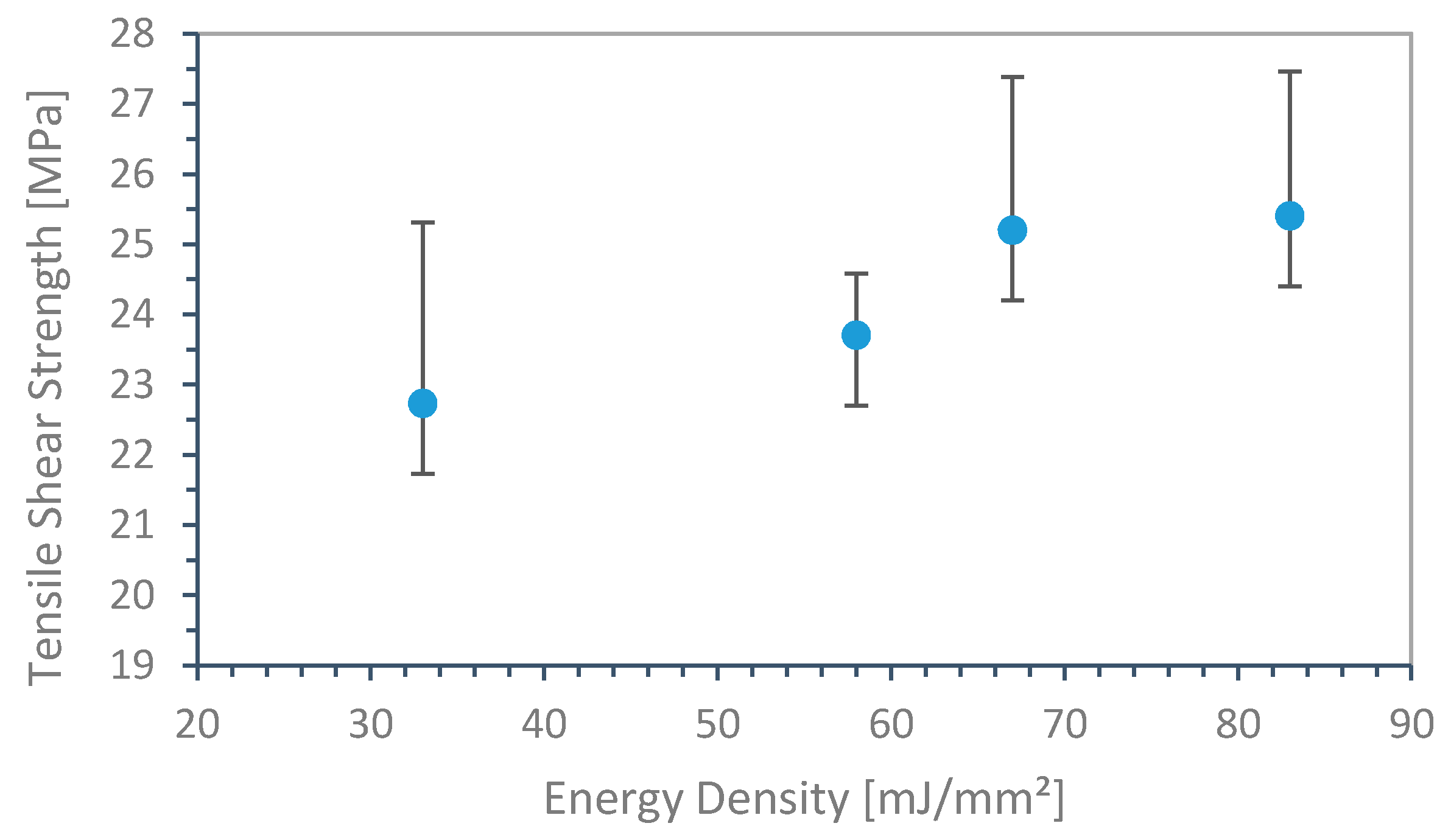


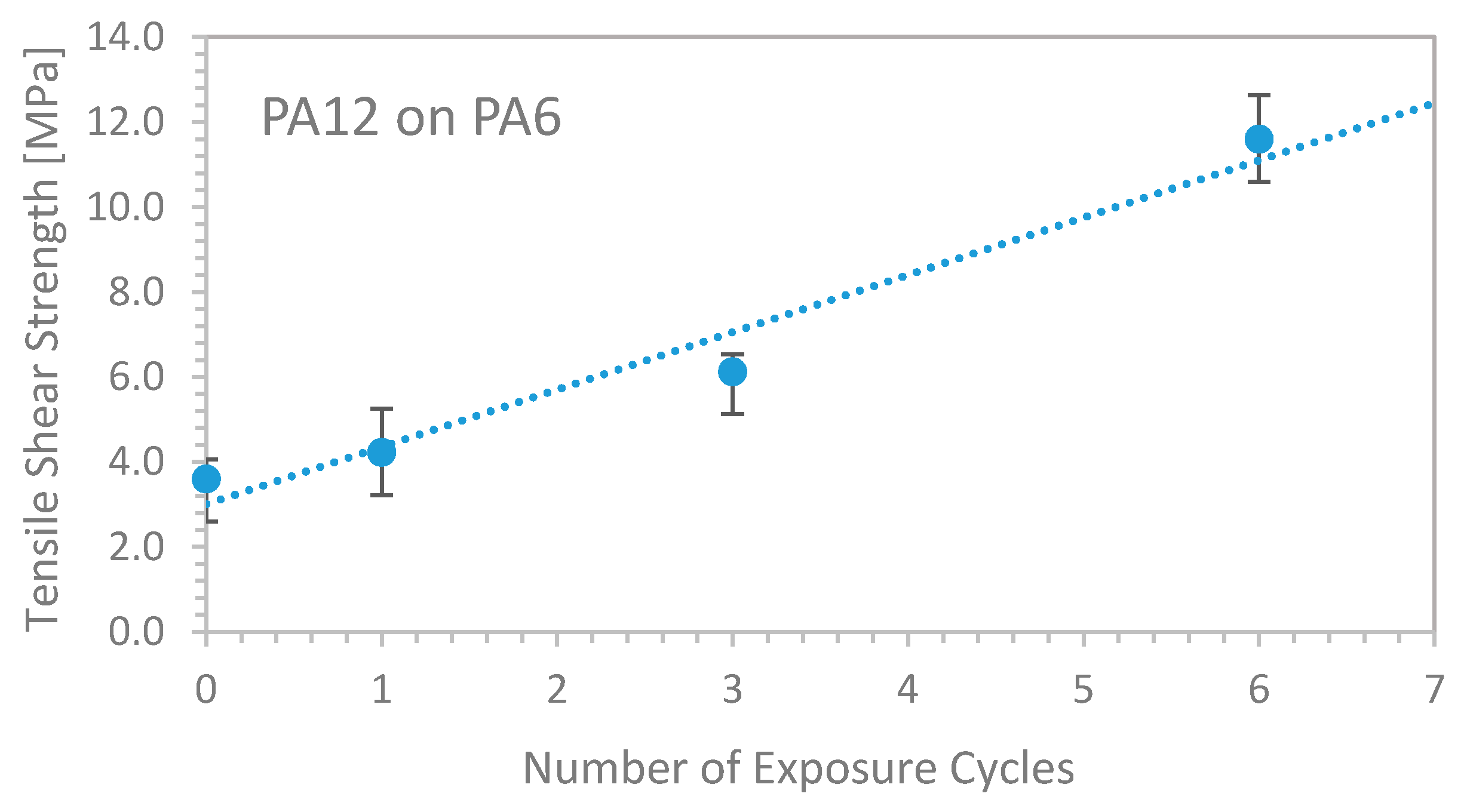

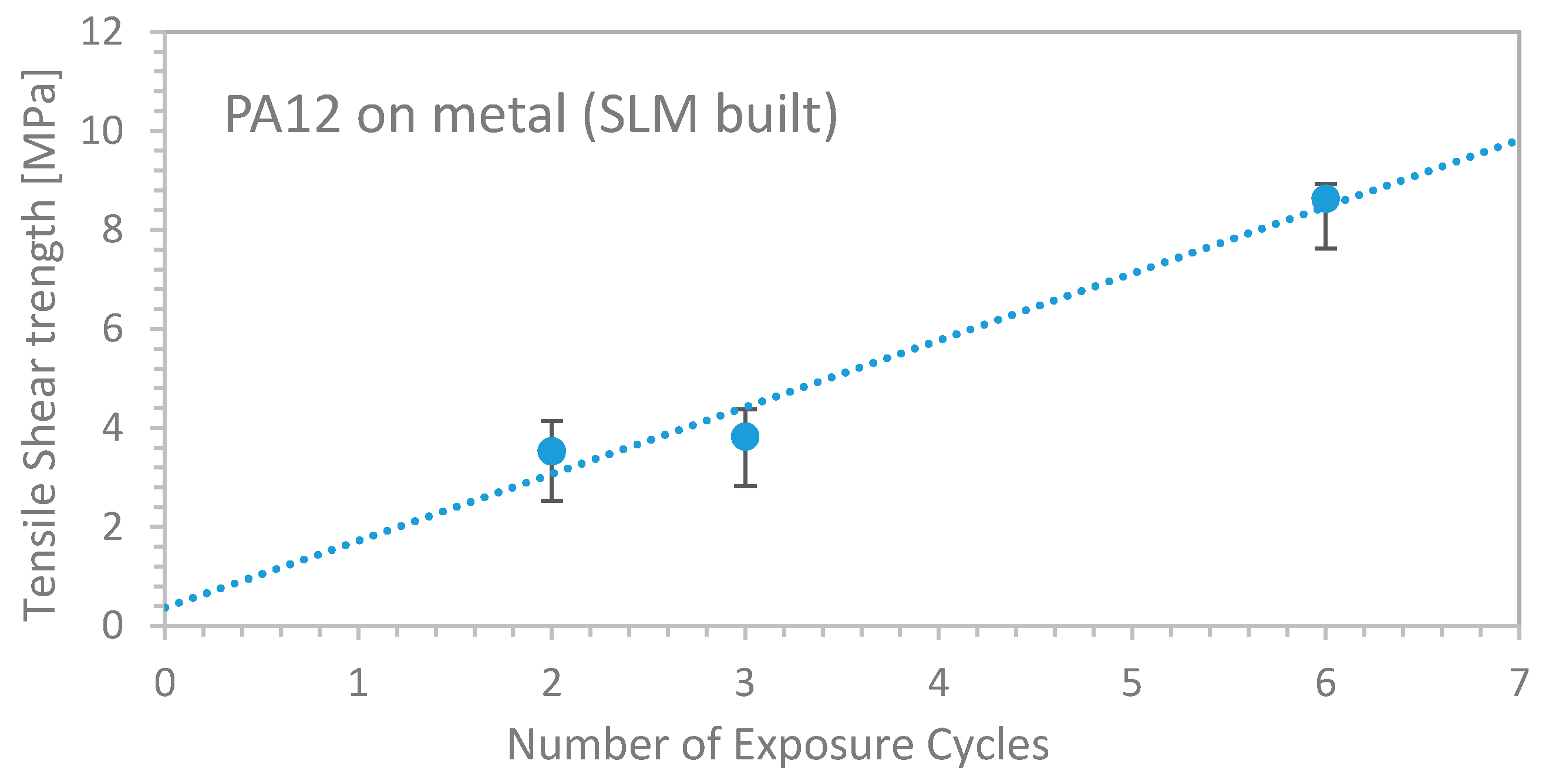
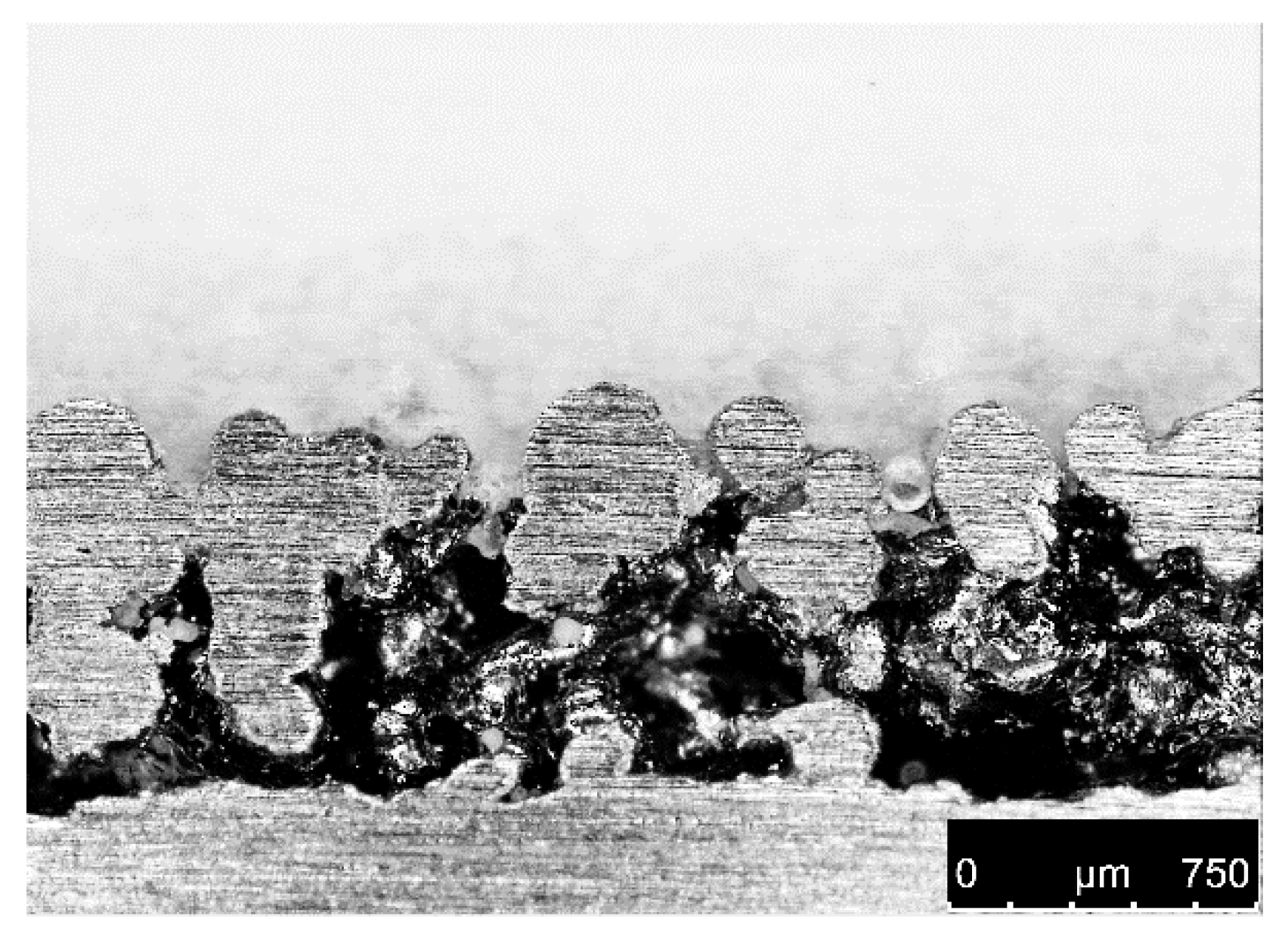
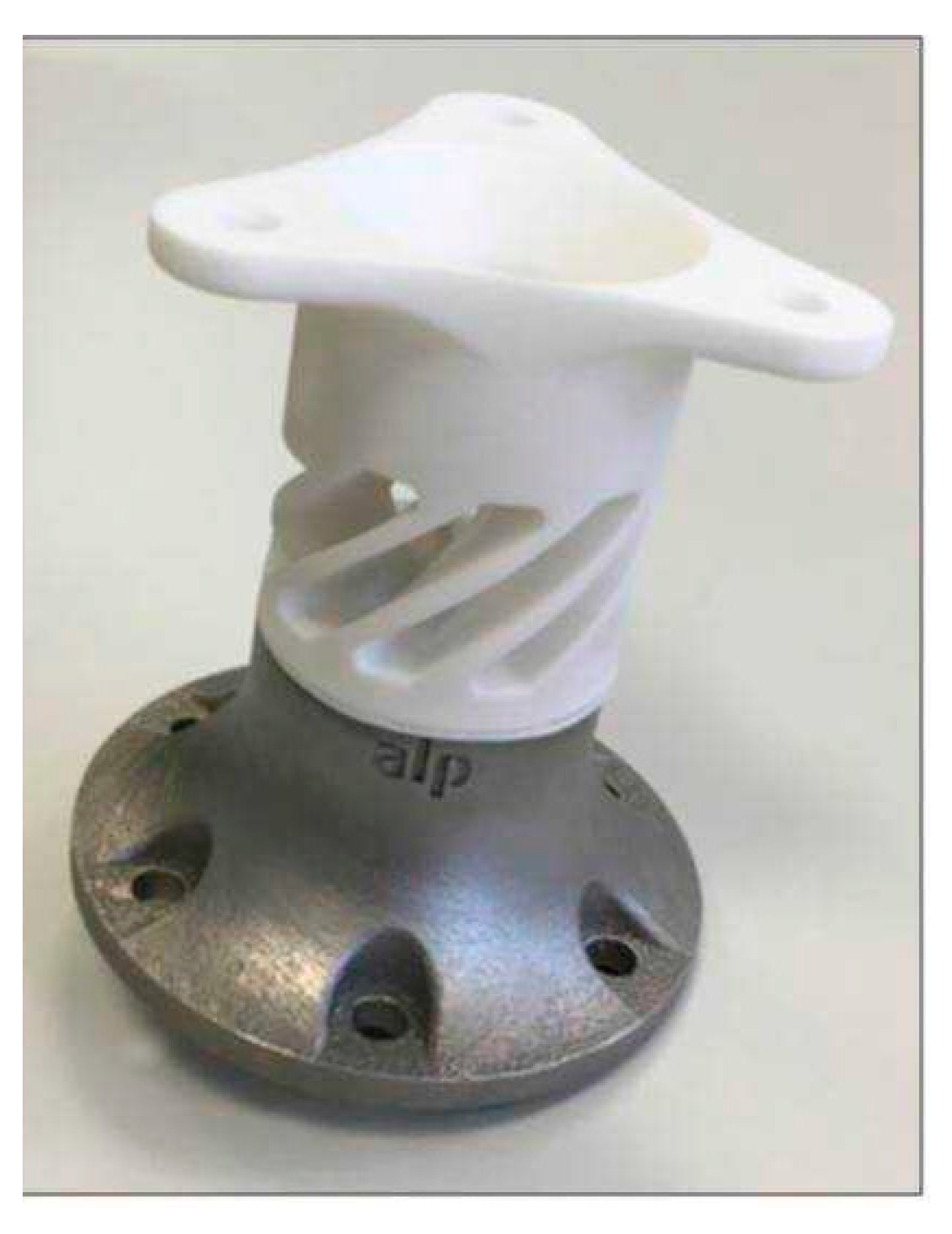
Publisher’s Note: MDPI stays neutral with regard to jurisdictional claims in published maps and institutional affiliations. |
© 2020 by the authors. Licensee MDPI, Basel, Switzerland. This article is an open access article distributed under the terms and conditions of the Creative Commons Attribution (CC BY) license (http://creativecommons.org/licenses/by/4.0/).
Share and Cite
Goetzendorfer, B.; Mohr, T.; Hellmann, R. Hybrid Approaches for Selective Laser Sintering by Building on Dissimilar Materials. Materials 2020, 13, 5285. https://doi.org/10.3390/ma13225285
Goetzendorfer B, Mohr T, Hellmann R. Hybrid Approaches for Selective Laser Sintering by Building on Dissimilar Materials. Materials. 2020; 13(22):5285. https://doi.org/10.3390/ma13225285
Chicago/Turabian StyleGoetzendorfer, Babette, Thomas Mohr, and Ralf Hellmann. 2020. "Hybrid Approaches for Selective Laser Sintering by Building on Dissimilar Materials" Materials 13, no. 22: 5285. https://doi.org/10.3390/ma13225285



